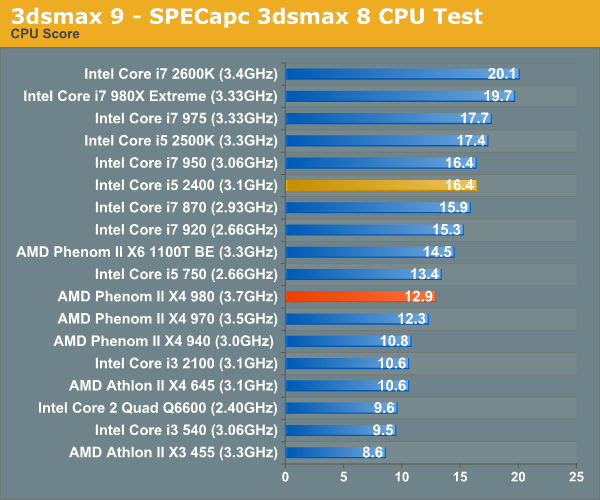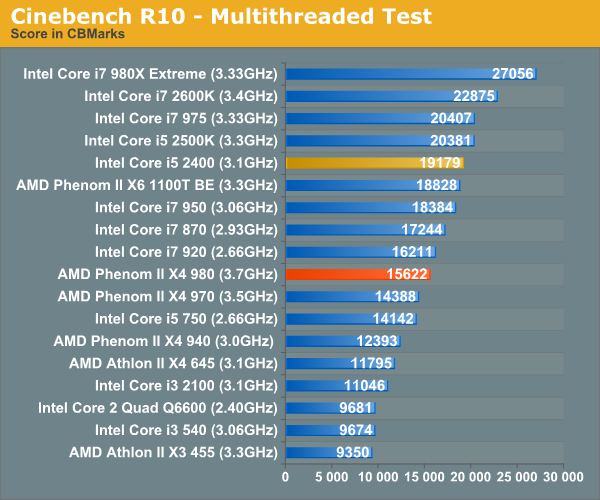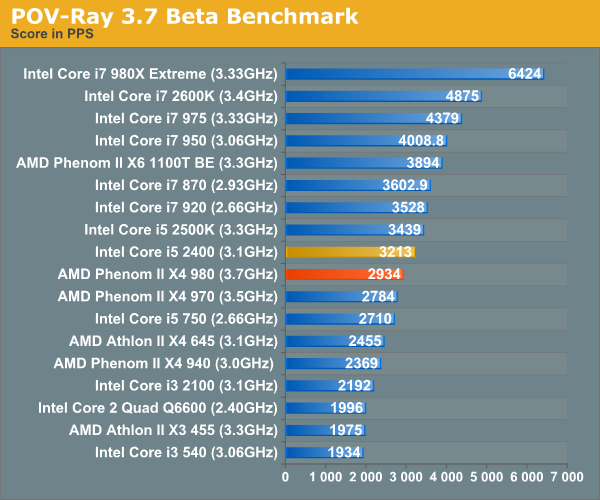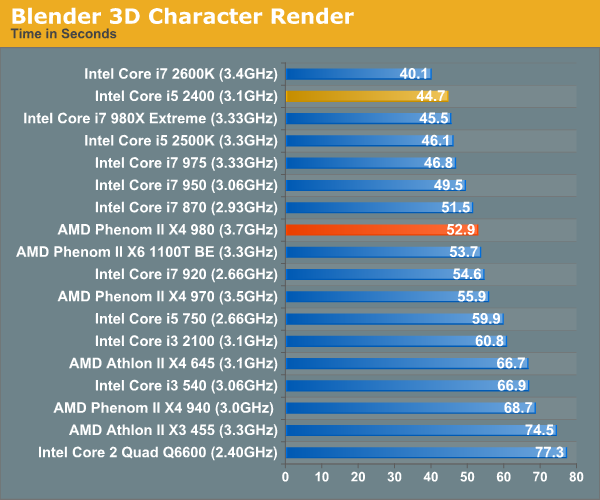AMD Phenom II X4 980 Black Edition Review
by Anand Lal Shimpi on May 2, 2011 10:42 PM EST3D Rendering Performance
Today's desktop processors are more than fast enough to do professional level 3D rendering at home. To look at performance under 3dsmax we ran the SPECapc 3dsmax 8 benchmark (only the CPU rendering tests) under 3dsmax 9 SP1. The results reported are the rendering composite scores.

Created by the Cinema 4D folks we have Cinebench, a popular 3D rendering benchmark that gives us both single and multi-threaded 3D rendering results.


POV-Ray is a popular, open-source raytracing application that also doubles as a great tool to measure CPU floating point performance.
I ran the SMP benchmark in beta 23 of POV-Ray 3.73. The numbers reported are the final score in pixels per second.












78 Comments
View All Comments
silverblue - Wednesday, May 4, 2011 - link
Phenom II came to market after Nehalem. Yes, it wasn't exactly meant to compete with it, and was more about sorting out what Phenom did wrong, but the unfortunate truth is that the i7 beat it to market.529th - I think the issue would be that you would be disabling a feature and thus not showing accurate performance, however that in itself would show the difference given by having Turbo in the first place. Doing the same with Thuban would be interesting.
Zosma would've made more sense than continuing on with Deneb, however AMD quickly shelved that idea.
GullLars - Wednesday, May 4, 2011 - link
Nah, it's just Intel has a huge advantage on fabs. They also have a clock for clock advantage on most workloads, but AMD's engineers are by no means incompetent. Brazos is the only recent great product though.If both Bulldozer and Lano fails spectacularly, i'll start leaning towards your side though. The last years Intel have alienated me with horrible business ethics and artificial restrictions on processors for market segmentation with very high prices on the chips that were not gimped (disabled functional units).
Hopefully power consumption will be better with GloFo.
silverblue - Wednesday, May 4, 2011 - link
Weren't you banned? No? Oh.Intel actually DOES need to make its compilers more vendor-agnostic since the settlement. If a piece of software works rather poorly on an AMD CPU and much better for an Intel offering, this isn't always down to the Intel CPU being stronger; it might actually be the result of the AMD CPU working on an inefficient codepath. Of course, it may actually be the limit of the processor. If something is compiled using a neutral compiler, I'd be far more inclined to trust the results of that.
I doubt Intel is forcing people to use their compiler nor are they making them develop for Intel-only platforms, however in the interests of fair competition it's only right that checking for the CPU ID tag be removed, if that is what they're doing.
silverblue - Wednesday, May 4, 2011 - link
Since you're such an expert, could you perhaps tell us, oh mighty one, what errata requires fixing? What is so buggy about an AMD processor?If you're going to make such bold statements, it's about time you actually backed them up with FACTS.
silverblue - Thursday, May 5, 2011 - link
Still waiting.silverblue - Wednesday, May 4, 2011 - link
The most popular CPUs are towards the lower end. Intel doesn't have a quad core CPU below $100 whereas AMD has multiple. There's no reason why an Athlon II X4 setup shouldn't easily undercut an i3 setup, and occasionally, four true cores will be a benefit.wh3resmycar - Wednesday, May 4, 2011 - link
why and why would are you still guys sticking to 1680x1050? don't give me the crap about correctly segmenting processor performance hence a cpu bound resolution for gameX.people who actually are gamers, who are looking for a quadcore and up cpu solutions are probably gaming at HD resolutions and upwards.
at least add graphs that are done on higher resolutions. your gaming performance benchmarks don't work in the real world.
stimudent - Sunday, May 8, 2011 - link
This is great hardware, but it seems that most everyone I know who is an average user has left their tower systems and switched to smart phones, iPads, and gaming consoles for the most part. These items are now being discussed at family get togethers instead of PCs as was the case just a few years ago. Some advanced users are using the latest graphics cards for computational projects instead of gaming - the CPU is no longer seen as the best way to fold. It's the graphics card doing the grunt work while the quad-core processor sits mostly idle.